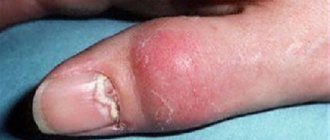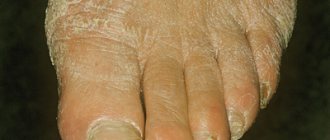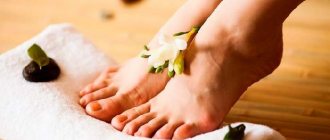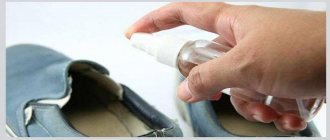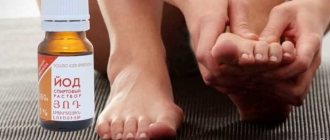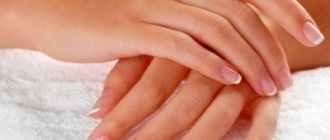Natural vinegar is not only a piquant spice, but also a real healing elixir, with the help of which various diseases have been treated for a long time.
Reliable treatment of nail fungus is guaranteed by regular use of medicinal formulations with vinegar. These methods of traditional medicine are not inferior in their effectiveness to modern drops and ointments.
Features of the disease
Nail fungus, or scientifically onychomycosis, is a frequently occurring problem faced by people of different ages and both sexes. The cause of discoloration and deformation of nails is rapidly multiplying dermatophytes (about 300 species of these pathogens are found in nature!), which easily penetrate the nail, corroding its top layer.
Important! The fungus affects the nail plates of the toes and hands with almost equal frequency.
The first signs of parasitic microorganisms:
- dry cuticle;
- cracking skin near the nail;
- cracks, inclusions, spots, grooves on the horny surface;
- redness and roughness of the skin around the nail plate;
- severe itching, feeling of discomfort in the affected area.
Sometimes pain may appear under the affected nail.
With the further development of pathogenic spores, the following occurs:
- separation of the nail plates;
- changes in the structure of the nail, its thickening;
- crumbling of the upper stratum corneum;
- a change in the shape and color of the nail from greenish-yellow to brown and even black, which indicates its peeling and death.
In parallel with these manifestations of the disease, an unpleasant odor may appear, and a white or yellowish coating often appears on the subungual bed.
Diagnosis of the disease
To diagnose the disease, you need to seek help from a specialist; only an experienced doctor can make the correct diagnosis and prescribe effective treatment.
To do this, the doctor first examines the patient, then sows the nail and skin underneath, checking them for the presence of fungus.
Once the presence of a fungal infection is established, the type of fungus and its sensitivity to drugs are determined. After this, the doctor prescribes the type of therapy to be performed and tells how to treat the fungus. In addition, you can use traditional medicine recipes, for example, iodine, tar, salicylic acid. These remedies are also used by doctors and various healers.
Why is nail fungus dangerous?
One of the main dangers of onychomycosis is a high degree of infection and rapid spread. For parasitic microorganisms to get into the nail and begin their destructive effect, it is enough to put on the shoes of a sick person (for example, slippers), use his towel, or simply walk on the same carpet (floor).
Important! As a result of the vital activity of the fungus, metabolic products are released that have toxic and allergenic properties, causing local and general reactions in the form of inflammation and intoxication of the entire body. If treatment is not timely, it will be much more difficult to cope with this insidious disease.
Visible manifestations of this process are expressed:
- allergic reactions;
- weakening of the protective functions of the immune system;
- exacerbation of chronic diseases.
Therefore, it is necessary to treat onychomycosis. It is advisable to do this from the appearance of the first alarming symptoms.
Shoe processing
You can use apple cider vinegar to treat shoes to reduce re-infection with a fungal infection.
A characteristic feature of onychomycosis and foot fungus is a high risk of re-infection. This occurs because fungal spores remain on shoes and socks, which penetrate the skin when items are worn repeatedly. Vinegar, which can be used to treat shoes, will help cope with this problem.
To do this, soak a cotton pad in vinegar and thoroughly rub the inside of the shoes. There is no need to rinse off the product; it evaporates quickly in the air. Another disinfection option is a mixture of vinegar and soap solution. To prepare, you need to dissolve two large spoons of laundry soap shavings and the same amount of vinegar essence in a glass of water. The solution should be poured into the shoes and left for half an hour. Then the product is poured out, the shoes are washed with water and dried naturally.
It is recommended to use vinegar to wipe shower trays, bathtubs and any surfaces that a person has come into contact with bare feet, as fungal spores may remain on them.
Vinegar can be used to disinfect socks. They should be washed as usual, then placed in a mixture of vinegar and water for 5 minutes and rinsed with water.
Can vinegar cure nail fungus?
Vinegar has been used for nail fungus for a very long time. Despite the emergence of a large number of new drugs, this method does not lose its relevance.
Traditional medicine recommends this spice as an independent remedy in the initial stages of the disease. Experts often prescribe solutions of acetic acid as part of complex treatment. In advanced forms of onychomycosis, recovery occurs with regular procedures over a long period of time. It is necessary to carry out treatment courses until the signs of the disease completely disappear.
Reviews
I had a fungus for a long time, very neglected. I didn’t pay much attention right away, but when the whole nail turned yellow, I went to the hospital. They prescribed medications and advised me to keep my feet in a vinegar solution to speed up the process. As they said, after the baths I applied the cream, and soon the old, painful nail fell off on its own.
Alexey, 46 years old.
The fungus has tormented me. I bought various ointments at the pharmacy, my nails seemed to go away, but later the fungus still returned. And then my wife read somewhere and made an ointment herself with vinegar and dissolved egg. And it helped! I recommend it to everyone.
Valery, 65 years old.
I got rid of the fungus with vinegar and iodine.
As written in the recipe, I mixed them in a bottle and applied them to the nail every day, morning and evening. It was a long story, almost six months, but now there is no fungus, and there were no adverse reactions. Valentina, 37 years old.
Features of treatment
When using vinegar against nail fungus, you need to pay attention to the specifics of its use.
This will protect you from unwanted side effects and ensure the desired treatment result.
First of all, be patient. For the final death of a pathogenic fungus, exposure to acetic acid should not be one-time, but repeated and regular. Therefore, treatment procedures must be carried out even after the symptoms of the disease disappear - until the healthy nail grows completely.
Secondly, note that the acid concentration can be different (6, 9 and 70%). The higher the strength of the solution, the stronger the effect of the acid.
Important! Under no circumstances should 70% pure essence be applied to the skin or nails!! It must be diluted with other ingredients included in the medicinal product.
Since the risk of burns increases with increasing strength of the solution, it is necessary to carefully monitor the sensations during the procedure. If you experience a tingling sensation and, especially, a burning sensation, it is necessary to dilute the remedy to a lower concentration of acetic acid.
To avoid discomfort, experts advise starting the procedure with the weakest vinegar solution (9%). After a few days, if the skin reaction is normal, you can try products prepared on the basis of a diluted 70% essence.
Note! If during the procedure irritation, swelling, or rash still appears on the skin, this indicates the development of an allergic reaction. In this case, treatment must be stopped.
Side effects and contraindications
Some people are intolerant to vinegar and other components. Therefore, if side effects appear in the form of a small rash, itching and burning, you must stop all procedures and consult a doctor.
Vinegar therapy has certain contraindications:
- children under 10 years of age;
- pregnancy;
- the presence of open wounds and damage to the tissues adjacent to the nail;
- psoriasis;
- eczema.
Women during breastfeeding can use vinegar for treatment, but only in consultation with their doctor.
Methods for treating nail fungus with vinegar
Traditional medicine suggests treating nail fungus with vinegar in several ways. In this case, you can use either 9% table vinegar or 6% apple cider vinegar, or diluted 70% essence.
The most well-known and used methods:
- compresses and lotions;
- ointments;
- baths.
The big advantage is the ease of preparation, low price and availability of the constituent ingredients with a good visible treatment result.
Compresses with vinegar
One of the popular formulations, which includes glycerin and vinegar, has been used for several decades to get rid of nail fungus.
Note! When carrying out this procedure, after applying the treatment to the affected area, a film is applied on top and heat is created (a woolen sock, gloves, etc. are put on, depending on the part of the body being treated).
There are several ways to prepare this mixture.
First recipe
- 2 tablespoons vinegar;
- 2 tablespoons of vodka;
- 1 tablespoon glycerin.
Prepare the mixture by moistening a small piece of cotton cloth, gauze folded in several layers or a cotton pad. Apply to the affected area and secure with a bandage. Make a compress for 20 - 30 minutes. Repeat daily until complete recovery.
Second recipe
- 2 tablespoons apple cider vinegar;
- 1 tablespoon glycerin;
- 2 drops of 5% iodine solution.
Mix the ingredients well. Apply a compress to the affected areas at night. Carry out the procedures for another 1.5-2 weeks after the symptoms of the disease disappear.
In addition to glycerin, other ingredients can be added to vinegar to prepare compresses:
- Tea tree oil has strong antifungal properties. Its use together with acetic acid enhances the damaging effect on the fungus. For a compress, add 4 drops of oil to 1 tablespoon of 9% vinegar.
- Egg white. To prepare the composition, take 2 tablespoons of slightly warmed water, vinegar essence and vodka. Add 3 egg whites and 1 tablespoon of glycerin to the resulting solution.
Mix all ingredients until smooth.
Third recipe
- Beat 1 raw egg with 1 teaspoon of dimethyl phthalate, 1 teaspoon of olive oil and acetic acid.
Note! Egg mixtures must be stored in the refrigerator.
Vinegar-based ointments for nail fungus
Traditional medicine offers many recipes for ointments made with vinegar. The components that form the basis of the product also have a therapeutic effect, improving the distribution of the ointment on the affected area.
With honey
- 1 tablespoon honey;
- 1 tablespoon vinegar;
- 2 tablespoons olive oil;
- 1 tablespoon Kalanchoe juice.
Mix the ingredients thoroughly. Apply a compress with ointment to the affected areas at night (7-8 hours). The procedures are continued until complete recovery.
Store the remedy in the refrigerator for no more than 2 weeks.
Recommendations
The advanced form is a more complex process that requires additional treatment steps. There is more than one recipe for preparing special mixtures, a recipe for baths, as well as many other treatment options. The recipe is quite simple, so no additional skills are required to prepare the mixture. You can easily find this or that recipe on the Internet.
Rules for preparing a special substance:
- acetic acid is added in the correct consistency, which is the basic rule for effective action. In the first days of use, it is recommended to use mixtures with a low consistency
- Before use, you should steam your feet in well-heated water, carefully remove keratinized areas of skin and delamination
- Vinegar should be used to treat not only sore spots, but also the entire foot and clothes that have been in contact with the fungus
- If there are cracks in the foot, it is not recommended to do similar procedures with vinegar, as this will lead to a burning sensation.
Precautions during treatment
Despite the positive effect that acetic acid has in the fight against fungus, precautions must be taken when using these traditional medicine methods.
Even in the weakest concentration, vinegar exhibits its acidic properties. Therefore, if you handle it carelessly or fail to comply with the dilution proportions, you can get a chemical burn and add another one to your problem.
Also, you should not use vinegar as a remedy for fungus:
- during pregnancy;
- against the background of severely reduced immunity;
- There are abrasions, wounds, cuts and cracks on the skin.
Analogs
Vinegar forms an acidic environment, due to which the fungi that cause mycoses die. The following drugs discussed in the table have a similar effect.
| Name | Description |
| BORIC ACID | A mixture with shiny inclusions obtained from the reaction of borax and sulfuric acid. The product is a powerful antiseptic and is widely used for nail fungus and other skin diseases. It is used in powder form for preparing baths and ointments. |
| SALICYLIC ACID | A chemical substance synthesized from willow bark. It has a local irritant, disinfectant and anti-inflammatory effect. It is used in the form of an alcohol solution and ointment of the same name. |
Additional measures to combat fungus
Treatment of nail fungus with vinegar essence will be successful if re-infection is prevented. Instruments used to treat affected nails and skin areas must be thoroughly washed and treated with alcohol or vinegar solutions after each use.
As a preventative measure, try to follow these recommendations:
- Wear special shoes (for example, rubber slippers) in public places, swimming pools, baths, saunas.
- Do not use other people's things, shoes, personal hygiene products.
- Carry out regular disinfection of places where infection is possible (baths, showers, etc.).
- Don't wear tight shoes. This increases foot sweating and creates good conditions for the rapid growth and spread of fungus throughout the foot.
We recommend reading: Apple cider vinegar for weight loss
Causes
Toenail fungus is considered a public disease. You can make a list of specific places where infection most often appears and nail plates become infected:
- Saunas, public baths, swimming pools. Infected skin flakes are found on the floor, gratings, paths, and benches. When indoor humidity is high, fungi actively multiply.
- Bathroom in the apartment. Here, intra-family infection occurs when using shared washcloths, towels, rugs, and grills.
- Poorly processed manicure tools.
- Shoes in stores when customers try them on on their bare feet.
- Beach - sand infected with contaminated skin particles settles on the nails. This method of infection is especially common in fresh water bodies.
Another important point: in most cases, the infection affects those who have a predisposition to onychomycosis.


